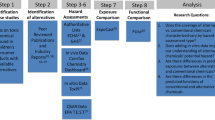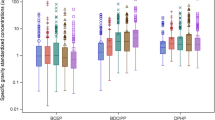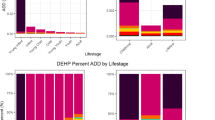Abstract
Many endocrine-disrupting chemicals (EDCs), including bisphenol A (BPA), are approved for use in food packaging, with unbound BPA migrating into the foods it contacts. Children, with their developing organ systems, are especially susceptible to hormone disruption, prompting this research to model the potential dose of BPA from school-provided meals. Probabilistic exposure models for school meals were informed by mixed methods. Exposure scenarios were based on United States school nutrition guidelines and included meals with varying levels of exposure potential from canned and packaged food. BPA exposure potentials were modeled with a range of 0.00049 μg/kg-BW/day for a middle school student with a low exposure breakfast and plate waste to 1.19 μg/kg-BW/day for an elementary school student eating lunch with high exposure potential. The modeled BPA doses from school meals are below the current US EPA Oral Reference Dose (RfD) of 50 μg/kg-BW/day. Recent research shows BPA animal toxicity thresholds at 2 μg/kg-BW/day. The single meal doses modeled in this research are at the same order of magnitude as the low-dose toxicity thresholds, illustrating the potential for school meals to expose children to chronic toxic levels of BPA.
This is a preview of subscription content, access via your institution
Access options
Subscribe to this journal
Receive 6 print issues and online access
$259.00 per year
only $43.17 per issue
Buy this article
- Purchase on Springer Link
- Instant access to full article PDF
Prices may be subject to local taxes which are calculated during checkout
Similar content being viewed by others
References
Gordon A, Crepinsek M, Nogales R, Condon E . School Nutrition Dietary Assessment Study-III Vol I: School Foodservice, School Food Environment, and Meals Offered and Served 2007. Office of Research, Nutrition and Analysis USDA, Food and Nutrition Service: Alexandria.
Institute of Medicine Nutrition Standards for Food in Schools: Leading the Way toward Healthier Youth. The National Academies Press: Washington, D.C.. 2007.
Institute of Medicine School Meals: Building Blocks for Healthy Children. The National Academies Press: Washington, D.C.. 2010.
Muncke J . Endocrine disrupting chemicals and other substances of concern in food contact materials: an updated review of exposure, effect and risk assessment. J Steroid Biochem Mol Biol 2011; 127: 118–127.
Goodson A, Robin H, Summerfield W, Cooper I . Migration of bisphenol A from can coatings—effects of damage, storage conditions and heating. Food Addit Contam 2004; 21: 1015–1026.
McNeal TP, Biles JE, Begley TH, Craun JC, Hopper ML, Sack CA . Determination of suspected endocrine disruptors in foods and food packaging In: Keith L, Jones-Lepp TL, Needham LL editors. Analysis of Environmental Endocrine Disruptors. American Chemical Society: Washington, D.C.. 2000 pp 33–52.
Munguia-Lopez EM, Soto-Valdez H . Effect of heat processing and storage time on migration of bisphenol A (BPA) and bisphenol A-diglycidyl ether (BADGE) to aqueous food simulant from Mexican can coatings. J Agric Food Chem 2001; 49: 3666–3671.
Munguia-Lopez EM, Gerardo-Lugo S, Peralta E, Bolumen S, Soto-Valdez H . Migration of bisphenol A (BPA) from can coatings into a fatty-food simulant and tuna fish. Food Addit Contam 2005; 22: 892–898.
Biles JE, McNeal TP, Begley TH, Hollifield HC . Determination of bisphenol-A in reusable polycarbonate food-contact plastics and migration to food-simulating liquids. J Agric Food Chem 1997; 45: 3541–3544.
Brede C, Fjeldal P, Skjevrak I, Herikstad H . Increased migration levels of bisphenol A from polycarbonate baby bottles after dishwashing, boiling and brushing. Food Addit Contam 2003; 20: 684–689.
Brotons JA, Olea-Serrano MF, Villalobos M, Pedraza V, Olea N . Xenoestrogens released from lacquer coatings in food cans. Environ Health Perspect 1995; 103: 608–612.
Yang CZ, Yaniger SI, Jordan VC, Klein DJ, Bittner GD . Most plastic products release estrogenic chemicals: a potential health problem that can be solved. Environ Health Perspect 2011; 119: 989–996.
Liao C, Kannan K . Widespread occurrence of bisphenol A in paper and paper products: implications for human exposure. Environ Sci Technol 2011; 45: 9372–9379.
Ozaki A, Yamaguchi Y, Fujita T, Kuroda K, Endo G . Chemical analysis and genotoxicological safety assessment of paper and paperboard used for food packaging. Food Chem Toxicol 2004; 42: 1323–1337.
Mercea P . Physicochemical processes involved in migration of bisphenol A from polycarbonate. J Appl Polym Sci 2009; 112: 579–593.
Cao XL, Perez-Locas C, Dufresne G, Clement G, Popovic S, Beraldin F et al. Concentrations of bisphenol A in the composite food samples from the 2008 Canadian total diet study in Quebec City and dietary intake estimates. Food Addit Contam 2011; 28: 791–798.
Lopez-Cervantes J, Paseiro-Losada P . Determination of bisphenol A in, and its migration from, PVC stretch film used for food packaging. Food Addit Contam 2003; 20: 596–606.
Wilson NK, Chuang JC, Morgan MK, Lordo RA, Sheldon LS . An observational study of the potential exposures of preschool children to pentachlorophenol, bisphenol-A, and nonylphenol at home and daycare. Environ Res 2007; 103: 9–20.
von Goetz N, Wormuth M, Scheringer M, Hungerbuhler K, Bisphenol A . how the most relevant exposure sources contribute to total consumer exposure. Risk Anal 2010; 30: 473–487.
Wilson NK, Chuang JC, Lyu C, Menton R, Morgan MK . Aggregate exposures of nine preschool children to persistent organic pollutants at day care and at home. J Expo Anal Environ Epidemiol 2003; 13: 187–202.
Lee BC, Kamata M, Akatsuka Y, Takeda M, Ohno K, Kamei T et al. Effects of chlorine on the decrease of estrogenic chemicals. Water Res 2004; 38: 733–739.
Sajiki J, Yonekubo J . Degradation of bisphenol-A (BPA) in the presence of reactive oxygen species and its acceleration by lipids and sodium chloride. Chemosphere 2002; 46: 345–354.
Geens T, Goeyens L, Kannan K, Neels H, Covaci A . Levels of bisphenol-A in thermal paper receipts from Belgium and estimation of human exposure. Sci Total Environ 2012; 435-436: 30–33.
Joskow R, Barr DB, Barr JR, Calafat AM, Needham LL, Rubin C . Exposure to bisphenol A from bis-glycidyl dimethacrylate-based dental sealants. J Am Dent Assoc 2006; 137: 353–362.
Olea N, Pulgar R, Perez P, Olea-Serrano F, Rivas A, Novillo-Fertrell A et al. Estrogenicity of resin-based composites and sealants used in dentistry. Environ Health Perspect 1996; 104: 298–305.
Calafat AM, Weuve J, Ye X, Jia LT, Hu H, Ringer S et al. Exposure to bisphenol A and other phenols in neonatal intensive care unit premature infants. Environ Health Perspect 2009; 117: 639–644.
Nachman RM, Hartle JC, Lees PS, Groopman JD . Early life metabolism of bisphenol A: a systematic review of the literature. Curr Environ Health Rep 2014; 1: 90–100.
Welshons WV, Thayer KA, Judy BM, Taylor JA, Curran EM, vom Saal FS . Large effects from small exposures. I. Mechanisms for endocrine-disrupting chemicals with estrogenic activity. Environ Health Perspect 2003; 111: 994–1006.
National Toxicology Program. NTP-CERHR Monograph on the Potential Human Reproductive and Developmental Effects of Bisphenol A. Research Triangle Park, NC2008.
Grun F, Blumberg B . Endocrine disrupters as obesogens. Mol Cell Endocrinol 2009; 304: 19–29.
Janesick A, Blumberg B . Endocrine disrupting chemicals and the developmental programming of adipogenesis and obesity. Birth Defects Res C Embryo Today 2011; 93: 34–50.
Rubin BS, Murray MK, Damassa DA, King JC, Soto AM . Perinatal exposure to low doses of bisphenol A affects body weight, patterns of estrous cyclicity, and plasma LH levels. Environ Health Perspect 2001; 109: 675–680.
Vom Saal FS, Nagel SC, Coe BL, Angle BM, Taylor JA . The estrogenic endocrine disrupting chemical bisphenol A (BPA) and obesity. Mol Cell Endocrinol 2012; 354: 74–84.
White House Task Force on Childhood Obesity. Solving the Problem of Childhood Obesity within a Generation, White House Task Force on Childhood Obesity Report to the President. Washington, D.C. 2010.
Trasande L, Attina TM, Blustein J . Association between urinary bisphenol A concentration and obesity prevalence in children and adolescents. JAMA 2012; 308: 1113–1121.
Muncke J . Exposure to endocrine disrupting compounds via the food chain: Is packaging a relevant source? Sci Total Environ 2009; 407: 4549–4559.
Miyamoto K, Kotake M . Estimation of daily bisphenol A intake of Japanese individuals with emphasis on uncertainty and variability. Environ Sci 2006; 13: 15–29.
Yamano Y, Miyakawa S, Iizumi K, Itoh H, Iwasaki M, Tsugane S et al. Long-term study of urinary bisphenol A in elementary school children. Environ Health Prev Med 2008; 13: 332–337.
United States Department of Agriculture. Child Nutrition Tables 2014 2014 [updated January 9, 2015 June 11, 2014]. Available from http://www.fns.usda.gov/pd/child-nutrition-tables.
Lakind JS, Naiman DQ . Daily intake of bisphenol A and potential sources of exposure: 2005-2006 National Health and Nutrition Examination Survey. J Expo Sci Environ Epidemiol 2011; 21: 272–279.
Nelson JW, Scammell MK, Hatch EE, Webster TF . Social disparities in exposures to bisphenol A and polyfluoroalkyl chemicals: a cross-sectional study within NHANES 2003-2006. Environ Health 2012; 11: 10.
Environmental Protection Agency. Bisphenol A. (CASRN 80-05-7) | IRIS | US EPA 2012 [cited 2012 August 12]. Available from http://www.epa.gov/iris/subst/0356.htm.
Hartle J . Food system contributions to bisphenol-A exposures [Dissertation]. 2013. Johns Hopkins University: Baltimore, MD: Baltimore, MD, https://jscholarship.library.jhu.edu/handle/1774.2/37123.
Nutrition Standards in the National School Lunch and School Breakfast Programs; Final Rule, 7 CFR Parts 210 and 220 2012.
Environmental Protection Agency Exposure Factors Handbook: 2011 Edition. National Center for Environmental Assessment Office of Research and Development: Washington, D.C.. 2011.
Centers for Disease Control and Prevention NHANES - Questionnaires, Datasets, and Related Documentation 2012. National Center for Health Statistics.
Cao XL, Corriveau J, Popovic S . Bisphenol A in canned food products from Canadian markets. J Food Prot 2010; 73: 1085–1089.
Goodson A, Summerfield W, Cooper I . Survey of bisphenol A and bisphenol F in canned foods. Food Addit Contam 2002; 19: 796–802.
Imanaka M, Sasaki K, Nemoto S, Ueda E, Murakami E, Miyata D et al. Determination of bisphenol A in foods using GC/MS. Shokuhin Eiseigaku Zasshi 2001; 42: 71–78.
Sajiki J, Miyamoto F, Fukata H, Mori C, Yonekubo J, Hayakawa K . Bisphenol A (BPA) and its source in foods in Japanese markets. Food Addit Contam 2007; 24: 103–112.
Schecter A, Malik N, Haffner D, Smith S, Harris TR, Paepke O et al. Bisphenol A (BPA) in U.S. food. Environ Sci Technol 2010; 44: 9425–9430.
Thomson BM, Grounds PR . Bisphenol A in canned foods in New Zealand: an exposure assessment. Food Addit Contam 2005; 22: 65–72.
Noonan GO, Ackerman LK, Begley TH . Concentration of bisphenol A in highly consumed canned foods on the U.S. market. J Agric Food Chem 2011; 59: 7178–7185.
Yoshida T, Horie M, Hoshino Y, Nakazawa H . Determination of bisphenol A in canned vegetables and fruit by high performance liquid chromatography. Food Addit Contam 2001; 18: 69–75.
Hornung RW, Reed LD . Estimation of average concentration in the presence of nondetectable values. Appl Occup Environ Hyg 1990; 5: 46–51.
Buzby JC, Guthrie JF . Plate Waste in School Nutrition Programs: Final Report to Congress 2002.
Lakind JS, Naiman DQ . Bisphenol A (BPA) daily intakes in the United States: estimates from the 2003-2004 NHANES urinary BPA data. J Expo Sci Environ Epidemiol 2008; 18: 608–615.
Volkel W, Colnot T, Csanady GA, Filser JG, Dekant W . Metabolism and kinetics of bisphenol A in humans at low doses following oral administration. Chem Res Toxicol 2002; 15: 1281–1287.
Volkel W, Bittner N, Dekant W . Quantitation of bisphenol A and bisphenol A glucuronide in biological samples by high performance liquid chromatography-tandem mass spectrometry. Drug Metab Dispos 2005; 33: 1748–1757.
Tsukioka T, Brock J, Graiser S, Nguyen J, Nakazawa H, Makino T . Development of analytical method for determining trace amounts of BPA in urine samples and estimation of exposure to BPA. J Environ Chem 2004; 14: 57–63.
Vandenberg LN, Colborn T, Hayes TB, Heindel JJ, Jacobs DR, Jr ., Lee DH et al. Hormones and endocrine-disrupting chemicals: low-dose effects and nonmonotonic dose responses. Endocr Rev 2012; 33: 378–455.
vom Saal FS, Hughes C . An extensive new literature concerning low-dose effects of bisphenol A shows the need for a new risk assessment. Environ Health Perspect 2005; 113: 926–933.
vom Saal FS, Welshons WV . Large effects from small exposures. II. The importance of positive controls in low-dose research on bisphenol A. Environ Res 2006; 100: 50–76.
European Food Safety Authority. FAQ on bisphenol A 2015 [cited 2015 February 23]. Available from http://www.efsa.europa.eu/en/faqs/faqbisphenol.htm.
Lopez-Espinosa MJ, Granada A, Araque P, Molina-Molina JM, Puertollano MC, Rivas A et al. Oestrogenicity of paper and cardboard extracts used as food containers. Food Addit Contam 2007; 24: 95–102.
Kang JH, Kondo F, Katayama Y . Human exposure to bisphenol A. Toxicology 2006; 226: 79–89.
Eladak S, Grisin T, Moison D, Guerquin MJ, N'Tumba-Byn T, Pozzi-Gaudin S et al. A new chapter in the bisphenol A story: bisphenol S and bisphenol F are not safe alternatives to this compound. Fertil Steril 2015; 103: 11–21.
Imanaka M . Study on phenol related compounds in foods and on their intake- A survey on bisphenol A intake from hospital meals 2001.
Food and Agriculture Organization/World Health Organization Joint FAO/WHO Expert Meeting to Review Toxicological and Health Aspects of Bisphenol A 2010. Ottawa, Canada.
European Food Safety Authority. Opinion of the Scientific Panel on food additives, flavourings, processing aids and materials in contact with food (AFC) related to 2,2-BIS(4-HYDROXYPHENYL)PROPANE (Bisphenol A). EFSA J 2006; 428: 1–75.
Health Canada. Health Risk Assessment of Bisphenol A from Food Packaging Applications In: Branch BoCSFDHPaF, editor. 2008 p. 1-14.
Food and Drug Administration Center for Food Safety and Applied Nutrition. Exposure to Bisphenol A (BPA) for infants, toddlers, and adults from the consumption of infant formula, toddler food and adult (canned) food. In: Health and Human Services, editor. 2009.
Acknowledgements
This investigation was supported by funds from the Center for a Livable Future-Lerner Doctoral Fellowship, Johns Hopkins University Bloomberg School of Public Health, Baltimore, MD.
Author information
Authors and Affiliations
Corresponding author
Ethics declarations
Competing interests
The authors declare no conflict of interest.
Rights and permissions
About this article
Cite this article
Hartle, J., Fox, M. & Lawrence, R. Probabilistic modeling of school meals for potential bisphenol A (BPA) exposure. J Expo Sci Environ Epidemiol 26, 315–323 (2016). https://doi.org/10.1038/jes.2015.58
Received:
Revised:
Accepted:
Published:
Issue Date:
DOI: https://doi.org/10.1038/jes.2015.58
Keywords
This article is cited by
-
The impacts of intrauterine Bisphenol A exposure on pregnancy and expression of miRNAs related to heart development and diseases in animal model
Scientific Reports (2020)
-
A regression-based model to predict chemical migration from packaging to food
Journal of Exposure Science & Environmental Epidemiology (2019)



